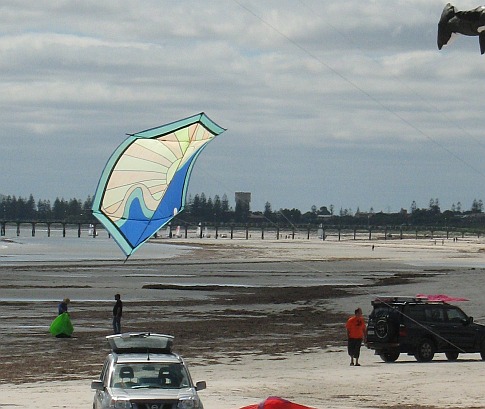- Home Page
- Flight Reports
A Flying Kite
Plenty of Flight Reports Here!
Is watching a flying kite one of your pleasures in life? Seeing your own creation up there definitely adds a new dimension to the experience. Read on for all sorts of kite-flying stories plus, of course, plenty of photos and some short videos.
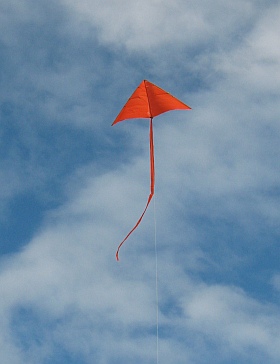 MBK Simple Delta
MBK Simple DeltaThis section of the site is devoted to a whole bunch of flight reports.
Some of these reports are full-length pages complete with a photo and video of the kite that I flew on the day. Other pages are compilations of my short-format blog posts for a particular type of kite.
For a year or so, this site had a couple of dedicated MBK Flight Reporters. These reporters built my designs, flew them, took photos, and then submitted great illustrated reports on their outings.
You just never know what random incident might happen while a kite is up. Nothing earth-shattering generally, but it's often enough to make the flier—or a number of the bystanders—crack a smile!
I've had the occasional tape failure in warm weather, which sends the kite gracefully out of control all the way to the ground.
I've had a seagull trip over the flying line in midair!
Once, a pelican joined the kite, hundreds of feet up in a thermal, before the large bird climbed away out of sight. And, of course, who hasn't had an encounter with a kite-eating tree!
You'll have to read all the reports to discover many other unexpected happenings that were recorded on the day. :-)
Everybody has a favorite kind of kite, so the reports are organized accordingly, below.
Sticked (oak dowel, bamboo skewer)
Indoor (plastic sails, paper/tape spars)
Paper (paper sails, paper/tape spars)
Soft (no sticks)
Whenever things are categorized, there are inevitably some items left over.
Hence read this miscellaneous kite posts page. :-)
Finally, the subject of a flight report occasionally covers more than one kite. Here's a collection of some of these slightly less-focused multiple-kite posts.
These next four links are to pages that bring together several flight-report posts which fit a theme. Which type of kite flier are you? Select the category that seems to fit best. :-)
Doing flight reports was my preferred method of keeping a record of my flights. However, it could be worth your while to keep a kite logbook. Check it out!
A Flying Kite
In Any Size You Like
From age 3 to 103, there's something for everyone with an MBK design. Here's a breakdown of the various categories by size:
- Multi-Dowel Series (very large, tailless, in e-books only)
- Dowel Series (large and tailless)
- Soft Series (medium sized, no spars)
- 3-Skewer Series (particularly good in light winds)
- 2-Skewer Series (modest sized, but high performance)
- 1-Skewer Series (small, but quick to make)
- Paper Series (small, only require paper and tape)
In addition, there are a few which don't neatly slot into any of the above categories.
Further down there are some photos of a flying kite in the various sizes along with some general information about them.
Wind-Speed Handy Reference
Light Air
1-5 kph
1-3 mph
1-3 knts
Beaufort 1
Light breeze
6–11 kph
4–7 mph
4–6 knts
Beaufort 2
Gentle ...
12–19 kph
8–12 mph
7–10 knts
Beaufort 3
Moderate ...
20–28 kph
13–18 mph
11–16 knts
Beaufort 4
Fresh ...
29–38 kph
19–24 mph
17–21 knts
Beaufort 5
Strong ...
39–49 kph
25–31 mph
22–27 knts
Beaufort 6
High Wind
50-61 kph
32-38 mph
28-33 knts
Beaufort 7
Gale
62-74 kph
39-46 mph
34-40 knts
Beaufort 8
Multi-Dowel Series
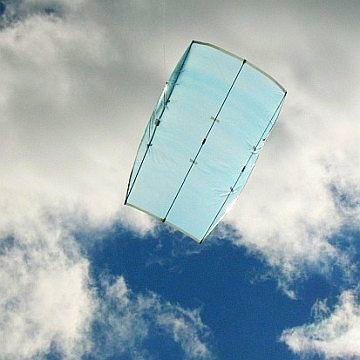 MBK Multi-Dowel Sled aka "The Horse"
MBK Multi-Dowel Sled aka "The Horse""Big" was once redefined here at MBK, after the 1.2-meter (4-foot) Dowel Series was complete.
So far in this series are the sled, diamond, barn door, rokkaku, delta, and box kites. The sled and box are 2.4 meters (8 feet) long, while the others have a span of that same amount. An exception is the mighty Multi-Dowel Delta, where each leading edge spar is 2.4 meters long!
These are a little more challenging to build, in comparison to all the other smaller and simpler designs. And due to the considerable pull they exert on the flying line, even in light winds, they are not for kids of any age!
Dowel Series
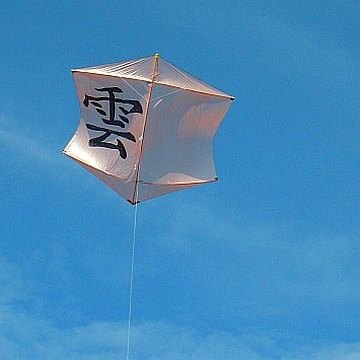 MBK Dowel Rokkaku—it says "clouds"
MBK Dowel Rokkaku—it says "clouds"The designs in this series were made with adults in mind, who want something of a decent size to fly. Older kids would also have the strength to handle these in most wind conditions.
The first thing you might notice about a flying kite of the Dowel Series variety is that it doesn't have a tail. Of course, there's nothing stopping you from adding a tail just for looks! These kites will fly a little higher and steeper without tails though.
These Dowel Series kites do best in light winds. It's not unusual for them to wander almost overhead when a thermal (region of rising air) passes across the field.
Soft Series
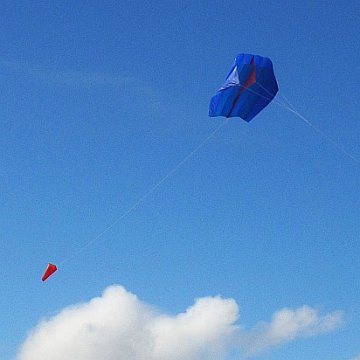 The MBK Parafoil has a wide wind range
The MBK Parafoil has a wide wind rangeThis parafoil is the third kite in the series. It's flying with a drogue here but doesn't really need it in most winds.
The main attraction of these designs is the fact you don't need to hunt around for spar material! Just drop-sheet plastic and packing tape is enough to get started on a kite that "looks like a bought one."
The kites in the Soft Series are all very distinct from one another both in looks and the way they fly.
3-Skewer Series
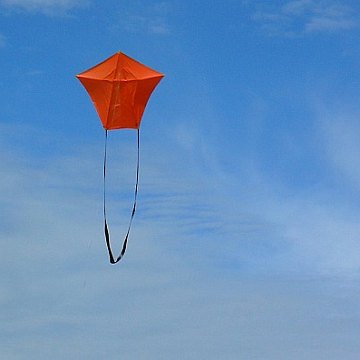 MBK 3-Skewer A-Frame just hanging still
MBK 3-Skewer A-Frame just hanging stillThe 3-Skewer kites have a span or height of ... you guessed it, the length of three 30-centimeter (12-inch) bamboo skewers. The length is a bit less actually, since the points need to be snipped off!
For anyone who wants to try sparred kites that fly in very light wind, the 3-skewer concept would be worth exploring further.
That brings to mind indoor flying. Yes, that's another world—towing kites around at low speeds. It involves playing around with climbs, glides, and other tricks in a hemispherical space.
2-Skewer Series
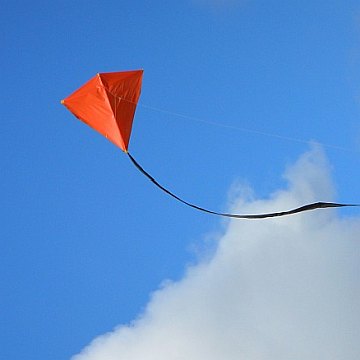 MBK 2-Skewer Diamond in a light breeze
MBK 2-Skewer Diamond in a light breezeI've had some fantastic flights with 2-Skewer Series kites on light-wind days. What I loved about them, personally, was that despite being fairly small, they hit a performance sweet-spot. Here's what I mean:
Two bamboo BBQ skewers end to end turns out to be a very ideal combination of strength, rigidity, and light weight. Add extremely light single-ply plastic, and you have one super-light-weight flying kite! Saving weight is what it's all about, as any kite maker will tell you.
Read the stories to see what some of these kites get up to on a long 20-pound Dacron line.
1-Skewer Series
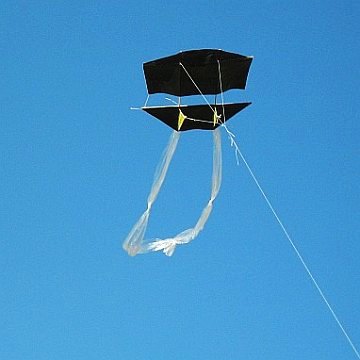 MBK 1-Skewer Dopero—a truly cute kite!
MBK 1-Skewer Dopero—a truly cute kite!The 1-Skewer Series kites have wingspans the length of a single BBQ skewer. The delta is actually a little wider than that, but both leading edge spars are a single BBQ skewer.
Most of the designs in this series are rarely seen in such small sizes. But I thought it would be fun to create them anyway!
How about a ... 29-centimeter (12-inch) wide dopero? See the black plastic one in the photo, complete with twin triangular keels cut from yellow plastic. This kite is just for moderate-wind fun. It's simply too tiny to lift a camera of any kind, unlike its much larger cousins.
At this size, a four-leg bridle needs the tiniest of adjustments to get the kite well trimmed, but it's worth the effort!
Paper Series
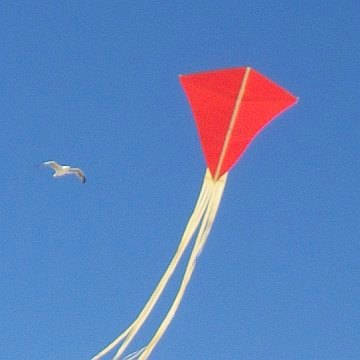 MBK Paper Diamond with a seagull
MBK Paper Diamond with a seagullThis series makes the task of gathering materials dead easy. Just find some copier paper and sticky tape!
And yet these kites have been designed to behave like real kites. That is, you can expect them to fly very high if desired—for as long as the wind blows!
A little care in handling is required, since they are only paper after all. But a well-kept Paper Series kite can easily return many hours of flying pleasure. Keep it for months or even years.
The weight of long copier-paper tails is a disadvantage. But these designs cope by being strong enough to fly in moderate-strength wind. Feel free to substitute light plastic or crepe tails if you want to!


